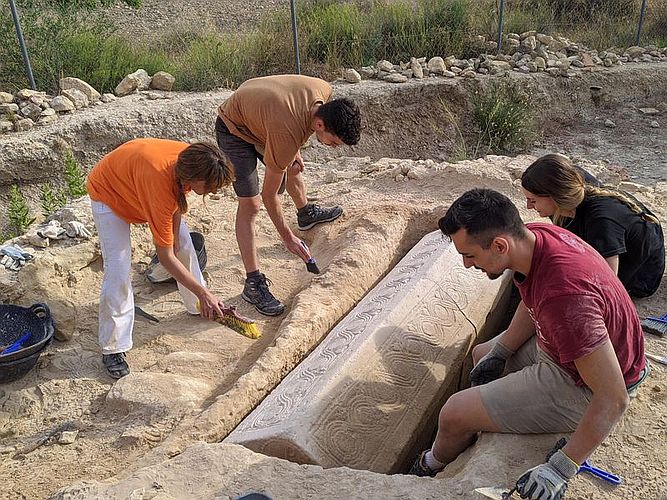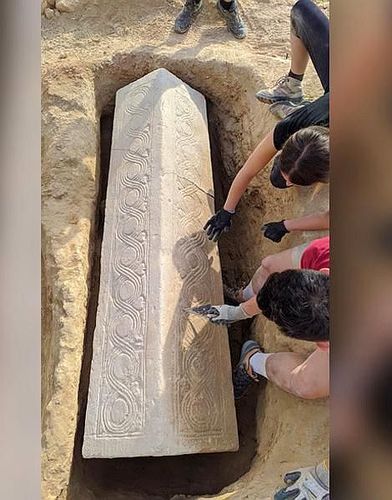World History
Related: About this forumWell-Preserved Visigoth Sarcophagus Found at Roman Villa in Spain
Researchers excavating Roman ruins at Los Villaricos in southern Spain have discovered a well-preserved coffin adorned with geometric patterns and interlocking ivy leaves. As local news outlet Murcia Today reports, the sarcophagus likely dates to the sixth century C.E., when the Visigoths, among other Germanic tribes, invaded territories formerly held by the fallen Roman Empire.
Archaeologists from the University of Murcia found the 6.5-foot-long coffin during a summer dig at Los Villaricos, a large-scale agricultural settlement established by the Romans around the first century C.E.
Per Heritage Daily, the sarcophagus was buried at a Roman villa repurposed by the Visigoths following its abandonment around the fifth century C.E. The Germanic conquerors used the structure’s central patio area as a necropolis.
According to Murcia Today, the team spotted a Chi Rho symbol carved on the top of the coffin. As Philip Kosloki explains for Aleteia, the monogram—also known as a Christogram—superimposes the first two letters of the Greek word for Christ: chi (X) and rho (P). It represents Jesus, or more specifically, his resurrection. The Roman emperor Constantine reportedly adopted the Chi-Rho symbol as a military standard after experiencing a vision while praying. Eventually, it became part of an official imperial emblem. The monogram also appears in many early Christian artworks.
Los Villaricos, for its part, was built along a trade route between Carthage and Complutum, a village northeast of Madrid, reports the Times. At its height, the ancient settlement relied heavily on agriculture, producing and storing olive oil, among other goods. The town went through a series of renovations during the Romans’ occupation of the region. After the Romans abandoned the area, the Visigoths moved in, seizing control and repurposing many Roman structures, including the villa in Los Villaricos.
https://www.smithsonianmag.com/smart-news/archaeologists-find-1500-year-old-visigoth-coffin-spain-180978294/


dweller
(27,644 posts)1 tall Visigoth
😳
✌🏻
Faux pas
(16,012 posts)That's a beauty ![]()
modrepub
(3,979 posts)Is probably a better description of the peoples who collectively inherited portions of the Late Roman Empire. These folks would have practiced a similar form of Christianity (Arianism taught to them by the followers of a Bishop Arius), dressed similarly to Romans, kept Roman law (for the Roman citizens they now governed) and generally governed in the name of the Emperor (who now resided in Constantinople).
In essence, they replaced the Roman administrators with their own. Not that the transition went smoothly or there wasn't substantial suffering. Roman practices were probably mostly continued. The Barbarians had their own culture but they were really too few in number to dominate the local Roman population. Instead, they tried to be accommodating at times and cooperate with the local Bishops to maintain some semblance of a functioning Roman society.
This would all change as Byzantium (under Justinian) began his reconquest in the mid 6th century. The Visigoths would endure Byzantine attacks, Justinian's plague and finally succumb to the the Arab conquest in the 8th century.
left-of-center2012
(34,195 posts)“Following their sack of Rome in 410 A.D.,
Visigoth influence extended from the Iberian Peninsula (present-day Portugal and Spain) all the way to Eastern Europe.”
https://www.history.com/topics/ancient-rome/goths-and-visigoths
modrepub
(3,979 posts)In 458, the Roman emperor Majorian defeated the Visigoths who at that time had dominated southern Gaul at the Battle of Arelate.
"[T]raveling with his generals Aegidius and Nepotianus, Majorian encountered the Visigothic king and his army at Arelate, at the mouth of the Rhodanus River (Rhone). The ensuing battle was an overwhelming Gothic defeat. Theodoric II was forced to flee Arelate, abandon Septimania, and conclude a hasty peace treaty. The treaty returned all Visigothic territory in Hispania to the Romans, and the Visigoths were reduced to federate status."
Majorian was probably the last emperor to physically lead a victorious Roman army and impose Roman authority outside the Italian Peninsula. His larger goal was to recover the African provinces who had been overrun by the Vandals in the late 430s. He was eventually betrayed, his invasion fleet destroyed by the Vandal fleet under Genseric. This weakened Majorian's tenuous hold on what remained of the Roman empire. He was forced to recognize Vandal supremacy over Africa and was later deposed, beaten and beheaded at the instigation of the Roman (Barbarian) Generalissimo or Patrician Ricimer.
After Majorian's removal, the Visigoths abandon their Federate status and regained control of the Iberian peninsula. Majorian's generals remaining in Gaul revolted and an already fragile Imperial situation outside the Italian peninsula basically became untenable. Majorian's rule, by most historical accounts, was the last chance of a Western Imperial revival. What followed was a parade of weak ineffective Emperors who could barely control events outside of Italy.
Gibbon said of Majorian that he "presents the welcome discovery of a great and heroic character, such as sometimes arise, in a degenerate age, to vindicate the honour of the human species".
Yes, the sack of Rome in 410 appears to be a turning point in Roman history. But Majorian's reign indicates that it was still possible for a gifted leader to unite and effectively wield the many factions of the later Roman Empire.